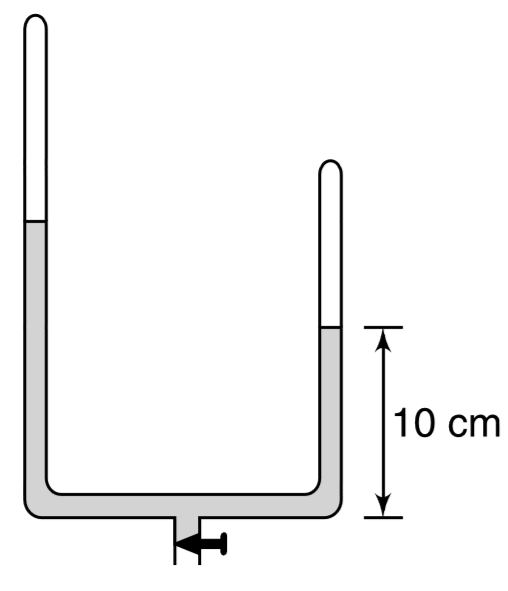A mercury manometer consists of two unequal arms of equal cross-section and length 100 cm and 50 cm. The two open ends are sealed with air in the tube at a pressure of 80 cm of mercury. Some amount of mercury is now introduced in the manometer through the stopcock connected to it. If mercury rises in the shorter tube to a length 10 cm in steady state, find the length of the mercury column risen in the longer tube.
For shorter arm , Initial volume of air = A × 50 cm
When mercury is introduced in the tube, the volume of air =A×40cm3
Let P1 be the pressure of the air in shorter arm, then by PV = constant, we have
80×(A×50)=P1×(A×40)
∴P1=100cm
For longer arm, Initial volume of air =A×100cm3
Let l0 be the length of mercury, then volume of air =A×(100−l0)
Let P2 be the pressure of the arm in the longer air, then by Pascal.s law PA=PB
l0+P2=10+P1
P2=(10+P1)−l0=(10+100)−l0=(110−l0) cm
Now by PV = constant, we have
(110−l0)×A(100−l0)=80×(A×100) (or) (110−l0)(100−l0)=8000
l20=210l0+3000=0,l0=15.5cm

Related Playlists
- BOOK - AAKASH SERIESCHAPTER - EXPANSION OF GASESEXERCISE - TEST YOUR SELF6videos
EXPANSION OF GASES
- BOOK - AAKASH SERIESCHAPTER - EXPANSION OF GASESEXERCISE - VERY SHORT ANSWER TYPE QUESTIONS18videos
EXPANSION OF GASES
- BOOK - AAKASH SERIESCHAPTER - ELEMENTS OF VECTORS EXERCISE - QUESTIONS FOR DESCRIPTIVE ANSWER10videos
ELEMENTS OF VECTORS
- BOOK - AAKASH SERIESCHAPTER - EXPANSION OF LIQUIDS EXERCISE - QUESTIONS FOR DESCRIPTIVE ANSWERS4videos
EXPANSION OF LIQUIDS
Similar Questions
The mercury manometer consists if two unequal arms of equal cross section 1 cm^(2) and lenghths 100cm and 50cm. The two open ends are sealed with air in the tube at a pressure of 80cm of mercurey. Some amount of mercury is now introduced in the manometer through the stopcock connected to it. If mercury rises in the shorter tube to a lenght 10cm in steady state, find the length of the mercury column risen in the longer tube.
View SolutionThe mercury manometer consists if two unequal arms of equal cross section 1 cm^(2) and lenghths 100cm and 50cm. The two open ends are sealed with air in the tube at a pressure of 80cm of mercurey. Some amount of mercury is now introduced in the manometer through the stopcock connected to it. If mercury rises in the shorter tube to a lenght 10cm in steady state, find the length of the mercury column risen in the longer tube.
View SolutionA U shaped tube has two arms of equal cross section and lengths l1=80 cm and l2=40 cm. The open ends are sealed with air in the tube at a pressure of 80 cm of mercury. Some mercury is now introduced in the tube through a stopcock connected at the bottom (the air is not allowed to leak out). In steady condition the length of mercury column in the shorter arm was found to be 10 cm. Find the length of the mercury column in the longer arm. Neglect the volume of the part of the tube connecting two arms and assume that the temperature is constant.
 View Solution
View SolutionA column of mercury of 10cm length is contained in the middle of a narrow horizontal 1m long tube which is closed at both the ends. Both the halves of the tube contain air at a pressure of 76 cm of mercury. By what distance will the column of mercury be displaced if the tube is held vertically?
View SolutionA mercury barometer reads 75cm in vertical position . If the tube is inclined by 60∘ to the vertical, the length of the mercury in the tube will be
View SolutionTwo tubes P and Q of lengths 100 cm and 30 cm have radii 0.1 mm and 0.2 mm, respectively. A liquid passing through the two tubes is entering P at a pressure of 60 cm of mercury-and leaving Q at a pressure of 55 cm of mercury. What is the pressure at the junction of Pand Q?
View SolutionA manometer reads the pressure of a gas in an enclosure as shown in the figure. The absolute and gauge pressure of the gas in cm of mercury is (take atmospheric pressure =76 cm of mercury)
View SolutionA manometer reads the pressure of a gas in an enclosure as shown in the figure. The absolute and gauge pressure of the gas in cm of mercury is (take atmospheric pressure =76 cm of mercury)
View SolutionA barometer tube reads 75 cm of Hg. If tube is : gradually inclined at an angle of 30∘ with horizontal, keeping the open end in the mercury container, then find the length of mercury column in the barometer ■ tube
View SolutionOne of the limbs of a mercury manometer is connected to a gas cylinder. The mercury level in the limb connected to the gas cylinder is 10 cm higher than that in the other limb. Then the gauge pressure of the gas is _______ cm of Hg.
View Solution

